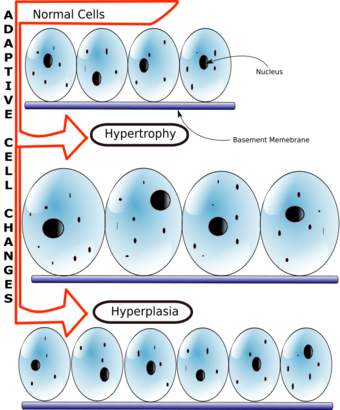Hyperplasia
Topic: Medicine
 From HandWiki - Reading time: 8 min
From HandWiki - Reading time: 8 min
This article may lack focus or may be about more than one topic. (December 2021) |
| Hyperplasia | |
|---|---|
 | |
| Whereas hypertrophy stems from an increase in cell size, hyperplasia results from an increase in cell number. | |
| Specialty | Pathology |
| Types | Benign prostatic hyperplasia, Hyperplasia of the breast(many more)[1][2] |
| Diagnostic method | Biopsy[3] |
| Treatment | Depends which type (see types) |
Hyperplasia (from ancient Greek ὑπέρ huper 'over' + πλάσις plasis 'formation'), or hypergenesis, is an enlargement of an organ or tissue caused by an increase in the amount of organic tissue that results from cell proliferation.[4] It may lead to the gross enlargement of an organ, and the term is sometimes confused with benign neoplasia or benign tumor.[5]
Hyperplasia is a common preneoplastic response to stimulus.[6] Microscopically, cells resemble normal cells but are increased in numbers. Sometimes cells may also be increased in size (hypertrophy).[7] Hyperplasia is different from hypertrophy in that the adaptive cell change in hypertrophy is an increase in the size of cells, whereas hyperplasia involves an increase in the number of cells.[8]
| -plasia and -trophy |
|---|
|
|
Causes
Hyperplasia may be due to any number of causes, including proliferation of basal layer of epidermis to compensate skin loss, chronic inflammatory response, hormonal dysfunctions, or compensation for damage or disease elsewhere.[9] Hyperplasia may be harmless and occur on a particular tissue. An example of a normal hyperplastic response would be the growth and multiplication of milk-secreting glandular cells in the breast as a response to pregnancy, thus preparing for future breast feeding.[10]
Perhaps the most interesting and potent[editorializing] effect insulin-like growth factor 1 (IGF) has on the human body is its ability to cause hyperplasia, which is an actual splitting of cells.[11] By contrast, hypertrophy is what occurs, for example, to skeletal muscle cells during weight training and is simply an increase in the size of the cells.[12] With IGF use, one is able to cause hyperplasia which actually increases the number of muscle cells present in the tissue.[13] Weight training enables these new cells to mature in size and strength. It is theorized that hyperplasia may also be induced through specific power output training for athletic performance, thus increasing the number of muscle fibers instead of increasing the size of a single fiber.[14]
Mechanism
Hyperplasia is considered to be a physiological (normal) response to a specific stimulus, and the cells of a hyperplastic growth remain subject to normal regulatory control mechanisms.[5] However, hyperplasia can also occur as a pathological response, if an excess of hormone or growth factor is responsible for the stimuli. Similarly to physiological hyperplasia, cells that undergo pathologic hyperplasia are controlled by growth hormones, and cease to proliferate if such stimuli are removed.[15] This differs from neoplasia (the process underlying cancer and benign tumors), in which genetically abnormal cells manage to proliferate in a non-physiological manner which is unresponsive to normal stimuli.[16] That being said, the effects caused by pathologic hyperplasia can provide a suitable foundation from which neoplastic cells may develop.[15]
Role in disease
Hyperplasia of certain tissues may cause disease. Pathologic hyperplasia in these tissues may occur due to infection, physiological stress or trauma, or abnormal levels of particular hormones, such as estrogen, ACTH, or cortisol.[17]
Types
Some of the more commonly known clinical forms of hyperplasia, or conditions leading to hyperplasia, include:
- Benign prostatic hyperplasia, also known as prostate enlargement.[1]
- Cushing's disease – Physiopathology of hyperplasia of adrenal cortex due to increased circulating level of ACTH (adrenocorticotropic hormone).[18]
- Congenital adrenal hyperplasia – Inherited disorder of gland (adrenal).[19]
- Endometrial hyperplasia – Hyperproliferation of the endometrium, usually in response to unopposed estrogen stimulation in the setting of polycystic ovary syndrome or exogenous administration of hormones. Atypical endometrial hyperplasia may represent an early neoplastic process which can lead to endometrial adenocarcinoma.[20] The development of endometrial adenocarcinoma from endometrial hyperplasia is a typical example of how the effects of pathologic hyperplasia can lead to neoplasia, and females who exhibit hyperplasia of the endometrium are indeed more likely to develop cancer of these cells.[15]
- Hemihyperplasia – When only half (or one side) of the body is affected, sometimes generating limbs of different lengths.[21]
- Hyperplasia of the breast – "Hyperplastic" lesions of the breast include usual ductal hyperplasia, a focal expansion of the number of cells in a terminal breast duct, and atypical ductal hyperplasia, in which a more abnormal pattern of growth is seen, and which is associated with an increased risk of developing breast cancer.[2]
- Intimal hyperplasia – The thickening of the tunica intima of a blood vessel as a complication of a reconstruction procedure or endarterectomy. Intimal hyperplasia is the universal response of a vessel to injury and is an important reason of late bypass graft failure, particularly in vein and synthetic vascular grafts.[22]
- Focal epithelial hyperplasia (also known as Heck's disease) – This is a wart-like growth in the mucous tissues of the mouth or, rarely, throat that is caused by certain sub-types of the human papillomavirus (HPV). Heck's disease has not been known to cause cancer.[23]
- Myofibre hyperplasia (also known as double-muscling) – seen in cattle, genetic mutations cause large muscles due to increased proliferation of myofibres and decreased adipose tissue.[24]
- Sebaceous hyperplasia – In this condition, small yellowish growths develop on the skin, usually on the face. This condition is neither contagious nor dangerous.[25]
- Compensatory liver hyperplasia – The liver undergoes cellular division after acute injury, resulting in new cells that restore liver function back to baseline. Approximately 75% of the liver can be acutely damaged or resected with seemingly full regeneration through hepatocyte division, i.e., hyperplasia. This is what makes living-donor liver transplants possible.[26]
- Epidermal hyperplasia of the skin[citation needed]
See also
References
- ↑ 1.0 1.1 "Prostate Enlargement (Benign Prostatic Hyperplasia)". National Institute of Diabetes and Digestive and Kidney Diseases (NIDDK). U.S. Department of Health and Human Services National Institutes of Health. https://www.niddk.nih.gov/health-information/urologic-diseases/prostate-problems/prostate-enlargement-benign-prostatic-hyperplasia.
- ↑ 2.0 2.1 Diagnostic Problems in Breast Pathology. Elsevier Health Sciences. 2009. ISBN 978-1-4160-2612-9. https://books.google.com/books?id=W2BzkJwU21kC&pg=PA33.
- ↑ Primary Care: The Art and Science of Advanced Practice Nursing. F.A. Davis. April 2011. ISBN 978-0-8036-2647-8. https://books.google.com/books?id=RR1hAQAAQBAJ&pg=PA709.
- ↑ "Hyperplasia". MedlinePlus Medical Encyclopedia. National Library of Medicine, U.S. Department of Health and Human Services National Institutes of Health. https://www.nlm.nih.gov/medlineplus/ency/article/003441.htm. Retrieved 2015-05-30.
- ↑ 5.0 5.1 Essentials of Medical Physiology. JP Medical Ltd. September 2012. ISBN 9789350259368. https://books.google.com/books?id=tdODr5fpxEAC&pg=PA20.
- ↑ Pathologic Basis of Veterinary Disease. Elsevier Health Sciences. December 2013. ISBN 978-0-323-29172-9. https://books.google.com/books?id=eLHQAgAAQBAJ&pg=PA289.
- ↑ Pathophysiology: Functional Alterations in Human Health. Lippincott Williams & Wilkins. 2007. p. 17. ISBN 978-0-7817-6250-2. https://archive.org/details/pathophysiologyf0000brau.
- ↑ Essentials of Rubin's Pathology. Lippincott Williams & Wilkins. 2009. ISBN 978-0-7817-7324-9. https://books.google.com/books?id=7HdzBBhtxycC&pg=PA2.
- ↑ Essentials of Pathophysiology: Concepts of Altered Health States. Lippincott Williams & Wilkins. 2011. ISBN 978-1-58255-724-3. https://books.google.com/books?id=FFg88IaReBwC&pg=PA775.
- ↑ Breast Surgical Techniques and Interdisciplinary Management. Springer Science & Business Media. January 2011. ISBN 978-1-4419-6076-4. https://books.google.com/books?id=ICfEsoKSwmsC&pg=PA188.
- ↑ Advanced Neuromuscular Exercise Physiology. Human Kinetics. ISBN 978-1-4504-1227-8. https://books.google.com/books?id=tTaLY-JpsJsC&pg=PA146.
- ↑ The Young Athlete: A Sports Doctor's Complete Guide for Parents. Little, Brown. October 2009. ISBN 978-0-316-08673-8. https://books.google.com/books?id=56QJzCNEjzkC&pg=PT126.
- ↑ The Endocrine System. Britannica Educational Publishing. November 2011. ISBN 978-1-61530-731-9. https://books.google.com/books?id=JemcAAAAQBAJ&pg=PA45.
- ↑ Therapeutic Exercise: Foundations and Techniques. F.A. Davis. December 2012. ISBN 978-0-8036-3897-6. https://books.google.com/books?id=udY-AAAAQBAJ&pg=PA169.
- ↑ 15.0 15.1 15.2 Robbins Basic Pathology. Philadelphia, US: Elsevier. 2013. pp. 4. ISBN 978-0-8089-2432-6.
- ↑ Holland Frei Cancer Medicine Eight. PMPH-USA. 2010. ISBN 978-1-60795-014-1. https://books.google.com/books?id=R0FbhLsWHBEC&pg=PA26.
- ↑ "Pathology: The Big Picture". AccessMedicine. McGraw Hill Medical. https://accessmedicine.mhmedical.com/book.aspx?bookid=499&isMissingChapter=true.
- ↑ "Cushing disease". MedlinePlus Medical Encyclopedia. National Library of Medicine, U.S. Department of Health and Human Services National Institutes of Health. https://www.nlm.nih.gov/medlineplus/ency/article/000348.htm. Retrieved 2015-05-30.
- ↑ "Congenital adrenal hyperplasia". MedlinePlus Medical Encyclopedia. National Library of Medicine, U.S. Department of Health and Human Services National Institutes of Health. https://www.nlm.nih.gov/medlineplus/ency/article/000411.htm. Retrieved 2015-05-30.
- ↑ "Endometrial Hyperplasia". American College of Obstetricians and Gynecologists (ACOG). http://www.acog.org/Patients/FAQs/Endometrial-Hyperplasia.
- ↑ "Hemihyperplasia - Glossary Entry". Genetics Home Reference. National Library of Medicine, U.S. Department of Health and Human Services. http://ghr.nlm.nih.gov/glossary=hemihyperplasia.
- ↑ "Analysis of arterial intimal hyperplasia: review and hypothesis". Theoretical Biology & Medical Modelling 4: 41. October 2007. doi:10.1186/1742-4682-4-41. PMID 17974015.
- ↑ Essentials of Oral Pathology. JP Medical Ltd. 2011. ISBN 9789350252147. https://books.google.com/books?id=fDRtoGmVGQQC&pg=PA9.
- ↑ Swatland, Howard (January 1974). "Developmental disorders of skeletal muscle in cattle, pigs and sheep". The Veterinary Bulletin 44 (4): 187–189. https://www.researchgate.net/publication/233398466.
- ↑ Skin Diseases in the Elderly: A Color Handbook. CRC Press. October 2011. ISBN 978-1-84076-615-8. https://books.google.com/books?id=fPMoxcB2XDwC&pg=PA85.
- ↑ Robbins & Cotran Pathologic Basis of Disease. Elsevier Health Sciences. September 2014. ISBN 978-0-323-29635-9. https://books.google.com/books?id=5NbsAwAAQBAJ&pg=PA36.
Further reading
External links
| Classification | |
|---|---|
| External resources |
{{Navbox
| name = Tumors | title = Overview of tumors, cancer and oncology (C00–D48, 140–239) | state = autocollapse | listclass = hlist
| group1 = Conditions
| list1 =
| Benign tumors | |
|---|---|
| Malignant progression | |
| Topography | |
| Histology | |
| Other |
| group2 = Staging/grading | list2 =
| group3 = Carcinogenesis | list3 =
- Cancer cell
- Carcinogen
- [[Biology:Tumor suppressor Tumor suppressor genes/oncogenes
- Clonally transmissible cancer
- Oncovirus
- Carcinogenic bacteria
| group4 = Misc. | list4 =
}}
 |
 KSF
KSF
